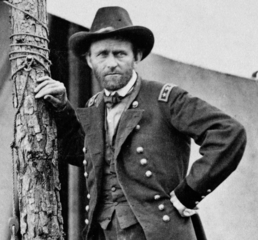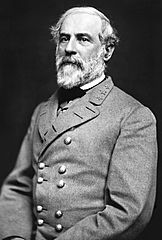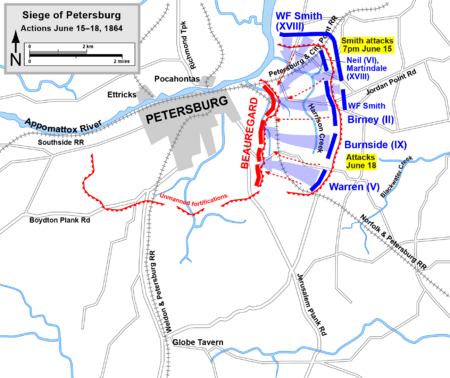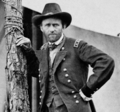Second Battle of Petersburg facts for kids
Quick facts for kids Second Battle of Petersburg |
|||||||
|---|---|---|---|---|---|---|---|
| Part of the American Civil War | |||||||
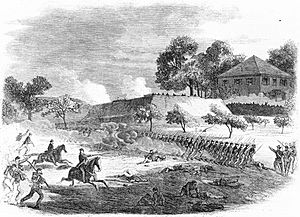 The war in Virginia – the 18th Army Corps storming a fort on the right of the Rebel line before Petersburg, June 15, sketch by Edwin Forbes (Dunn House at the Confederate Dimmock Line) |
|||||||
|
|||||||
| Belligerents | |||||||
| Commanders and leaders | |||||||
| Ulysses S. Grant George G. Meade |
Robert E. Lee P. G. T. Beauregard |
||||||
| Units involved | |||||||
| Army of Northern Virginia | |||||||
| Strength | |||||||
| 13,700–62,000 (reinforcements arrived over four days) | 5,400–38,000 | ||||||
| Casualties and losses | |||||||
| 11,386 total
(1,688 killed,
8,513 wounded, 1,185 missing or captured) |
4,000 total
(200 killed,
2,900 wounded, 900 missing or captured) |
||||||
The Second Battle of Petersburg, also called the Assault on Petersburg, happened from June 15 to 18, 1864. It was the start of the Richmond–Petersburg Campaign, often known as the Siege of Petersburg. During this battle, Union forces, led by Lieutenant General Ulysses S. Grant and Major General George G. Meade, tried to capture Petersburg, Virginia. They wanted to take the city before General Robert E. Lee's Confederate Army of Northern Virginia could arrive to protect it.
For four days, the Union army launched repeated attacks against much smaller Confederate forces. These Confederate troops were commanded by General P. G. T. Beauregard. Beauregard's strong defenses and some mistakes by Union generals, especially Major General William F. "Baldy" Smith, helped the Confederates hold their ground. By June 18, many more soldiers from Lee's army arrived, making it too hard for the Union to keep attacking. Because the Union army couldn't capture Petersburg quickly, it led to a long, ten-month siege of the city.
Contents
Why Was Petersburg Important?
The city of Petersburg was a very important place during the American Civil War. It had many railroad lines that brought supplies to Richmond, which was the capital city of the Confederacy. If the Union army could capture Petersburg, it would cut off Richmond's supplies. This would force General Lee's army to leave Richmond and fight Grant's army in the open.
Before this battle, on June 9, there was a smaller fight called the First Battle of Petersburg. During that battle, Union Major General Benjamin Butler sent about 4,500 soldiers to attack Petersburg. The Confederates, led by General P. G. T. Beauregard, had only 2,500 defenders. Many of these defenders were young teenagers and older men. However, the Union attack failed because their leaders were too cautious. This showed Grant that Petersburg's defenses were weak and could be taken if he acted quickly.
After a tough battle at Cold Harbor, Lieutenant General Ulysses S. Grant moved his Union Army of the Potomac away from General Robert E. Lee's army. Grant secretly began moving his troops across the James River to attack Petersburg. Grant knew that speed was key. He needed to capture Petersburg before Lee realized what was happening and sent more soldiers to defend it. Lee didn't fully understand Grant's plan until June 18, thinking Grant was still aiming for Richmond. But Beauregard had been warning everyone about the danger to Petersburg since June 9.
Grant chose Butler's Army of the James to lead the attack on Petersburg. He ordered Brigadier General William F. "Baldy" Smith's troops to be ready with 16,000 men. The Union II Corps, led by Major General Winfield S. Hancock, was to follow Smith. Grant believed that Petersburg could have been captured easily at that time.
The Confederates had strong defenses around Petersburg called the Dimmock Line. These were powerful artillery positions connected by earthworks and trenches that stretched for over 10 miles (16 km). Beauregard didn't have enough men to defend the whole line. So, he put about 2,200 soldiers in the northeastern part of the line. Even with these soldiers, they were spread out, about 10 feet (3 meters) apart.
Who Fought in the Battle?
| Main Commanders |
|---|
|
The main commanders for the Union army were Lieutenant General Ulysses S. Grant and Major General George G. Meade. They led the Army of the Potomac and the Army of the James. The Union forces started with about 13,700 soldiers, but this grew to 62,000 as more troops arrived over the four days.
For the Confederate army, the main commanders were General Robert E. Lee and General P. G. T. Beauregard. They led the Army of Northern Virginia. The Confederates began with about 5,400 soldiers, growing to 38,000 by the end of the battle.
Key Moments of the Battle
June 15: Union Attacks Begin
On the morning of June 15, Baldy Smith and his Union soldiers crossed the Appomattox River. Their plan was to attack the Confederate defenses. However, there were many delays. Transport boats dropped soldiers in the wrong places, and they had to waste time getting organized.
Later, Smith's cavalry, led by Brigadier General August Kautz, found a strong Confederate position. Kautz's men were stopped by Confederate artillery fire and eventually pulled back because they didn't hear Smith's main attack starting.
When Smith finally began his attack, his soldiers quickly took over some of the Confederate earthworks. They captured several batteries and forced the Confederates to fall back to a weaker line. Even with this success and a nearly undefended city in front of him, Smith decided to wait until the next morning to attack again. Major General Winfield S. Hancock arrived and, though he outranked Smith, he agreed to wait. This delay was a big mistake for the Union. Smith's cautious actions on this day led to him being removed from command later.
Meanwhile, General Beauregard used this precious time wisely. He didn't get any help or instructions from Richmond, so he decided to move soldiers from another defensive line, the Howlett Line, to help defend Petersburg. This brought more Confederate troops, including those led by Major Generals Robert Hoke and Bushrod Johnson, to the new Petersburg defense line.
June 16: Confederates Hold Their Ground
By the morning of June 16, Beauregard had gathered about 14,000 soldiers to defend Petersburg. However, they were facing about 50,000 Union soldiers. General Grant arrived and ordered his troops to find weak spots in the Confederate line. Major General Winfield S. Hancock was in temporary command of the Union army until Major General George G. Meade arrived. Hancock organized the Union forces for another attack.
The Union attack started around 5:30 p.m. All three Union corps moved slowly forward. Beauregard's soldiers fought bravely, even building new defenses behind them as the Union troops tried to break through. When General Meade arrived, he ordered a second attack. Brigadier General Francis C. Barlow led his division against Confederate positions. Heavy Confederate artillery fire caused many Union soldiers to be hurt or captured. Even though Barlow's men captured their targets, a Confederate counterattack pushed them back. The Union survivors then dug in close to the enemy lines.
June 17: More Union Attacks Fail
June 17 saw more uncoordinated Union attacks. Early in the morning, two brigades from Burnside's IX Corps, led by Brigadier General Robert B. Potter, launched a surprise attack. They were successful at first, capturing almost a mile of Confederate defenses and about 600 prisoners. But they couldn't advance further because they found another line of trenches. Their movement was also limited by tangled logs, and Confederate guns could fire on them from the side.
In the afternoon, the IX Corps attacked again, but they were sent forward at a bad angle, making them easy targets for Confederate fire. Another attack in the evening also failed.
During the day, Beauregard's engineers had prepared new defensive positions about a mile west of the Dimmock Line. Late that night, the Confederates quietly moved back to this new, stronger position. Beauregard was frustrated because General Lee had not sent him help earlier. Lee finally realized the danger to Petersburg when his own son confirmed Grant's movements. Lee immediately sent two divisions of his tired soldiers to Petersburg, starting at 3 a.m. on June 18.
June 18: Lee's Army Arrives
With the arrival of Lee's two divisions, Beauregard now had over 20,000 soldiers to defend Petersburg. But Grant's army had also grown, with Major General Gouverneur K. Warren's V Corps arriving, bringing the total Union forces to 67,000.
The first Union attack on June 18 began at dawn. The Union II and XVIII Corps attacked first. Major General Winfield S. Hancock was not feeling well from an old wound, so Major General David B. Birney took command of the II Corps. The Union soldiers were surprised to make quick progress, not realizing that Beauregard had moved his defenses back during the night. When they reached the new Confederate line, their attack stopped, and they faced heavy fire for hours.
By noon, the IX and V Corps joined the attack. Major General Orlando B. Willcox's division of the IX Corps led a new attack, but they suffered many losses in the marshy and open fields. Warren's V Corps was also stopped by intense fire from a strong Confederate position. Colonel Joshua Lawrence Chamberlain, a famous Union officer, was severely wounded in this attack.
At 6:30 p.m., Meade ordered a final assault, but it also failed with terrible losses. One regiment, the 1st Maine Heavy Artillery Regiment, lost 632 men in this attack, which was the highest single-battle loss for any regiment during the entire war.
What Happened Next?
After four days of attacks with almost no gains, Major General George G. Meade ordered his Union army to dig in. The Union army had lost about 11,386 soldiers (including those hurt or captured), while the Confederates lost about 4,000.
Grant's chance to capture Petersburg easily was gone. However, General Lee, who arrived at Petersburg around noon on June 18, could not stop the Union army from starting a siege of the city. This siege would last for a very long time, until April 1865.
Images for kids
-
Ltg. Ulysses S. Grant, USA
-
General Robert E. Lee, CSA
See also
 In Spanish: Segunda Batalla de Petersburg para niños
In Spanish: Segunda Batalla de Petersburg para niños


